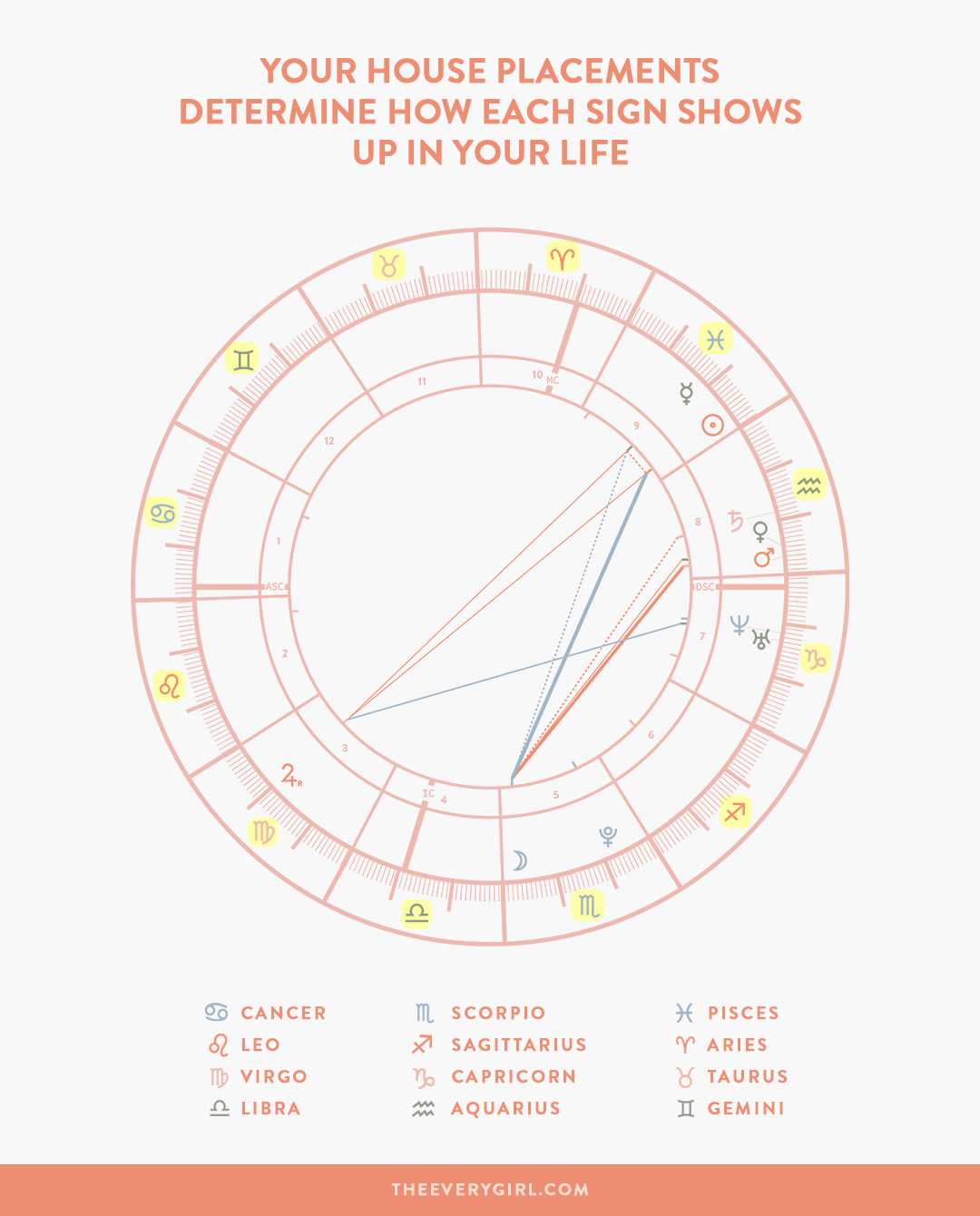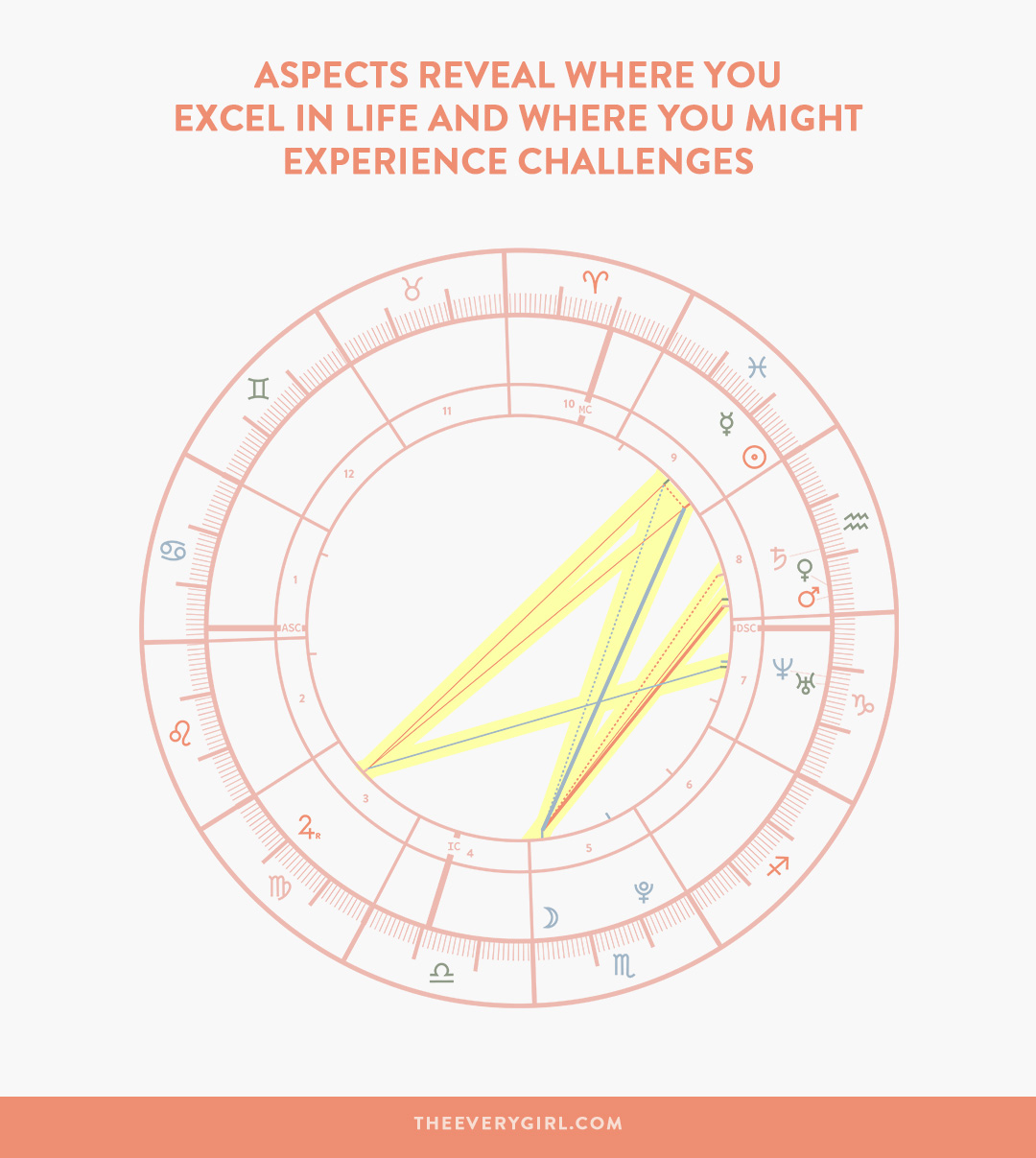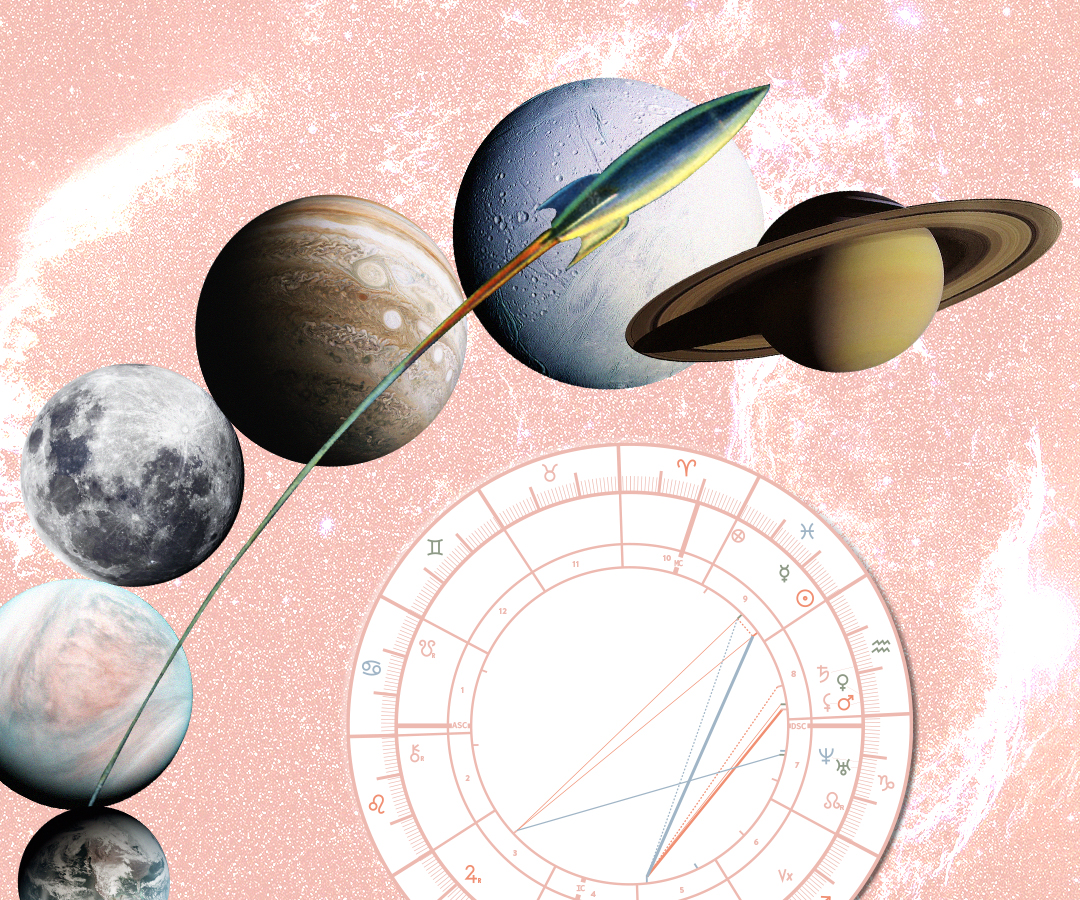There’s nothing that makes me more excited than finding out someone’s zodiac sign—whether it’s a coworker, someone I just met, or even a celebrity. And finding out their entire astrology birth chart? That’ll make my whole day (and the next hour or so will probably be spent analyzing said zodiac chart).
If you’re into astrology, you probably already know what a birth chart is. If you’re not familiar, though, it’s basically a picture of where all the planets were in the sky at the exact moment of your birth, and no two people have the exact same chart!
If you’ve ever looked at a birth chart, though, you probably know that they’re super complex. There are all kinds of symbols, segments, and lines, and if you’re not familiar with what it all means, it might look like an entirely different language.
So if you want to learn how to read your birth chart, you’ve come to the right place. Keep reading to find out the basic elements of a chart and how to interpret them.
Calculating your birth chart
The first step to finding your chart is going to a birth chart calculator website like this one. Enter your birthdate, place, and time (Tip: If you don’t know your exact time of birth, ask your mom or look on your birth certificate).
I recommend selecting Whole Sign houses as the house system in extended settings. With this house system, each house is ruled by one sign, making understanding transits (movements of planets) much easier.
For the purposes of this story, we’ll be looking at the below birth chart as an example:

Signs
You’re probably familiar with your zodiac sign. When trying to understand your birth chart, though, it’s important to know a little about the qualities of the rest of the signs because everyone has all 12 in their chart (more on that below).
Elements:
- Fire signs (Aries, Leo, Sagittarius): Passionate, energetic, enthusiastic
- Earth (Taurus, Virgo, Capricorn): Down to Earth, patient
- Air (Gemini, Libra, Aquarius): Intellectual, social, talkative
- Water (Cancer, Scorpio, Pisces): Emotional, nurturing, perceptive
Modalities:
- Cardinal (Aries, Cancer, Libra, Capricorn): Leaders, initiate things
- Fixed (Taurus, Leo, Scorpio, Aquarius): Stable, thorough, persistent
- Mutable (Gemini, Virgo, Sagittarius, Pisces): Flexible, adaptable, good at multitasking
Planets

You might know your sun, moon, and rising signs. These are called the big three for a reason—they’re the core of your identity. But there are many other placements that make up different sides of your personality, too.
The planets below are called personal planets because they move quickly, meaning the sign they’re in is different from person to person.
- Sun: Your identity
- Moon: The inner you, how you process and handle emotions, your mother
- Venus: What you find aesthetically pleasing, what you appreciate or look for in someone you’re dating
- Mercury: How you communicate
- Mars: How you take action
Along with the personal planets, there are also generational, or outer, planets. These are farther from the Earth and move more slowly, staying in one sign for about 1-30 years. So everyone born around the same time as you will have these planets in the same signs. How they show up in your individual life depends on the houses they’re placed in (again, that’s why the rising is so important!).
- Saturn (28.5 years): Hard work, restrictions, boundaries
- Jupiter (1 year): Expansion, luck
- Neptune (14 years): Idealism, intuition, spirituality, confusion or delusions
- Uranus (7 years): Change, independence
- Pluto (14-30 years): Death and rebirth, transformation
Houses

The houses are the segments of the birth chart wheel. Everyone has all 12 signs in their chart because each house is ruled by one sign (but you may not have planets in each sign/house).
Your rising sign determines the first house (for example, I’m a Gemini rising, so my first house is ruled by Gemini), and it sets up the order of signs in your birth chart. So if your first house is Gemini, the second will be Cancer, the third will be Leo, and so on. The rising is determined by your birth time, and since it determines your whole chart, it’s super important to have your exact time of birth.
Below are the themes associated with each house and its traditional rulers. Knowing the qualities of the signs can also help you understand the themes of each house. For example, Gemini is known for a love of learning and strong communication skills, which translate to the areas of life the third house (traditionally ruled by Gemini) represents.
And don’t freak out if you have empty houses in your chart—it’s not a bad thing. It just means there’s less of an emphasis on that area of your life.
- First house: Ruled by Aries, identity, self-image
- Second house: Ruled by Taurus, skills, values, possessions, money
- Third house: Ruled by Gemini, communication, short distance travel, early education, siblings, neighbors
- Fourth house: Ruled by Cancer, home, family
- Fifth house: Ruled by Leo, creativity, self-expression, fun, romance, children
- Sixth house: Ruled by Virgo, routines, health, daily tasks, work, coworkers, pets
- Seventh house: Ruled by Libra, marriage, close relationships
- Eighth house: Ruled by Scorpio, others’ money, intimacy, taboo topics
- Ninth house: Ruled by Sagittarius, long-distance travel, learning, higher education, belief systems
- Tenth house: Ruled by Capricorn, career, what you’re known for (pertaining to career)
- Eleventh house: Ruled by Aquarius, community, friends, groups, collaboration
- Twelfth house: Ruled by Pisces, mental health, alone time
Angles

The angles are the two lines that divide the wheel vertically and horizontally, and they represent the horizon (Ascendant/Descendant line) and the meridian (IC/Midheaven line).
- Ascendant: The ascendant is also called the rising sign. This indicates how others perceive you, how you view the world, and first impressions of you.
- Descendant: The descendant is directly opposite the ascendant, located in the seventh house. This angle represents qualities that you might look for or like to have in a partner.
- Imum Coeli (IC): The IC is located at the bottom of the zodiac wheel and represents your home, family, and where you come from (childhood or family experiences, etc.).
- Midheaven (MC): The midheaven indicates your life purpose, legacy, and public image, and it’s opposite the IC.
Aspects

Aspects are how the planets and angles are connected to each other, and you can find them by looking at the lines in the middle of your chart. Hard aspects—conjunction, opposition, and square—mean that there’s tension between two placements. This could mean challenges in a certain area of life or having difficulty expressing the traits of one of those planets. On the other hand, easy or soft aspects—sextile and trine—indicate that there’s a positive flow of energy between them. They’re basically helping each other out.
Putting it together
Once you understand what each planet, house, and angle means, you can combine it all. Be sure to look at the sign and house to tell you how each placement is expressed in your life.
For example, in the sample birth chart their moon is in the fifth house in Scorpio. That could mean they feel most themselves when doing creative work or expressing themselves, and they might be really passionate about their hobbies or interests. They also likely have super intense emotions and may fall hard when dating. With their Cancer rising, they might seem hard to get to know but very emotional. And their sun in the ninth house in Pisces could indicate they’re very spiritual or enjoy learning about other cultures, and they might love traveling.
Reading a birth chart is pretty complicated, and there are so many elements to a chart that if I included them all, this would be a much longer article! There are even entire books written on the topic. These are some good ones for beginners interested in learning more:
- Spiritual Astrology by Jan Spiller and Karen McCoy
- Hellenistic Astrology: The Study of Fate and Fortune by Chris Brennan
- The Essential Guide to Practical Astrology by April Elliott Kent
- Saturn Return Survival Guide by Lisa Stardust
- The Astrology of You and Me by Gary Goldschneider
These are the basics you need to know to get started on understanding your chart—and hopefully getting to know yourself a little better.
More Zodiac Stories for You


 "
"
